Fiscal Policy, Economic Growth, and National Finances During COVID-19
VerifiedAdded on 2022/12/29
|8
|1660
|75
Essay
AI Summary
This essay delves into the economic repercussions of the COVID-19 pandemic, focusing on the crucial role of fiscal policy in mitigating its effects. It analyzes the various fiscal measures implemented by governments globally, including increased spending, tax adjustments, and financial support programs, and their impact on national finances and economic growth. The essay also examines the impact of the pandemic on various industries, the decline in tax revenue, and the rise in unemployment. Furthermore, it explores the 'Keynesian' responses adopted by different countries, contrasting them with austerity measures and monetary policy reliance, while also assessing the legacy of large deficits and debt. The essay underscores the importance of fiscal policy in stabilizing economies during times of crisis, highlighting its role in protecting livelihoods and ensuring access to essential services.
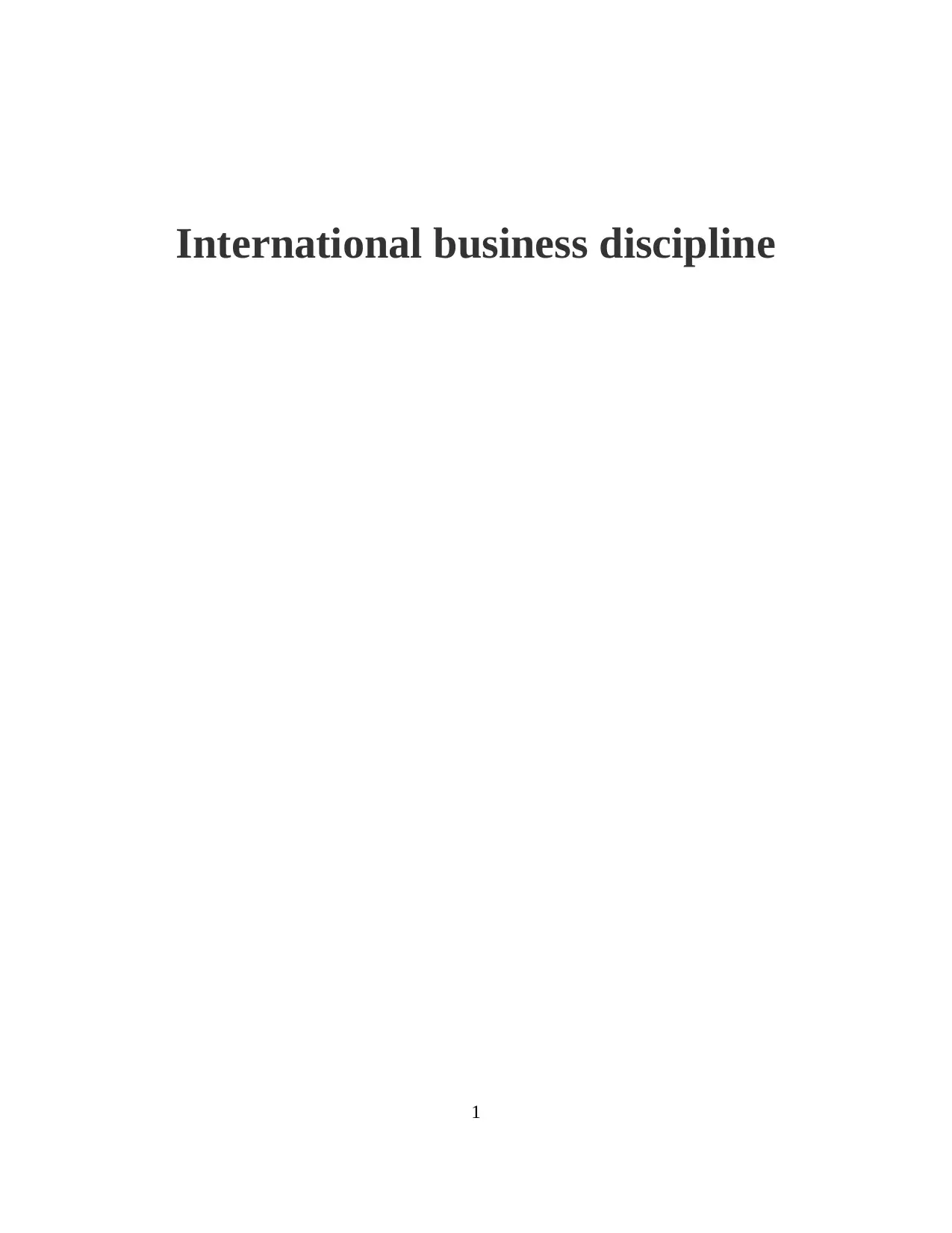
International business discipline
1
1
Paraphrase This Document
Need a fresh take? Get an instant paraphrase of this document with our AI Paraphraser
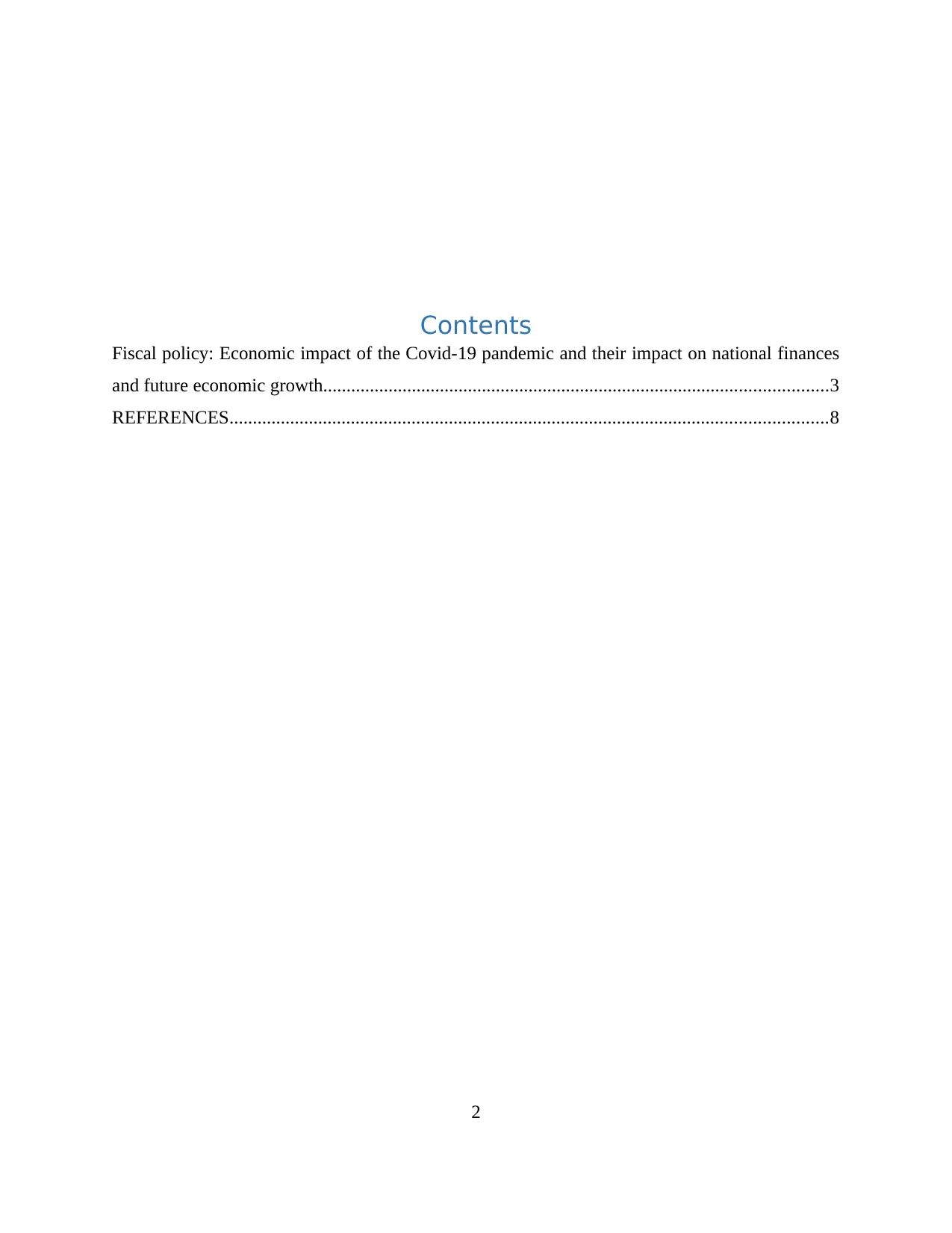
Contents
Fiscal policy: Economic impact of the Covid-19 pandemic and their impact on national finances
and future economic growth............................................................................................................3
REFERENCES................................................................................................................................8
2
Fiscal policy: Economic impact of the Covid-19 pandemic and their impact on national finances
and future economic growth............................................................................................................3
REFERENCES................................................................................................................................8
2
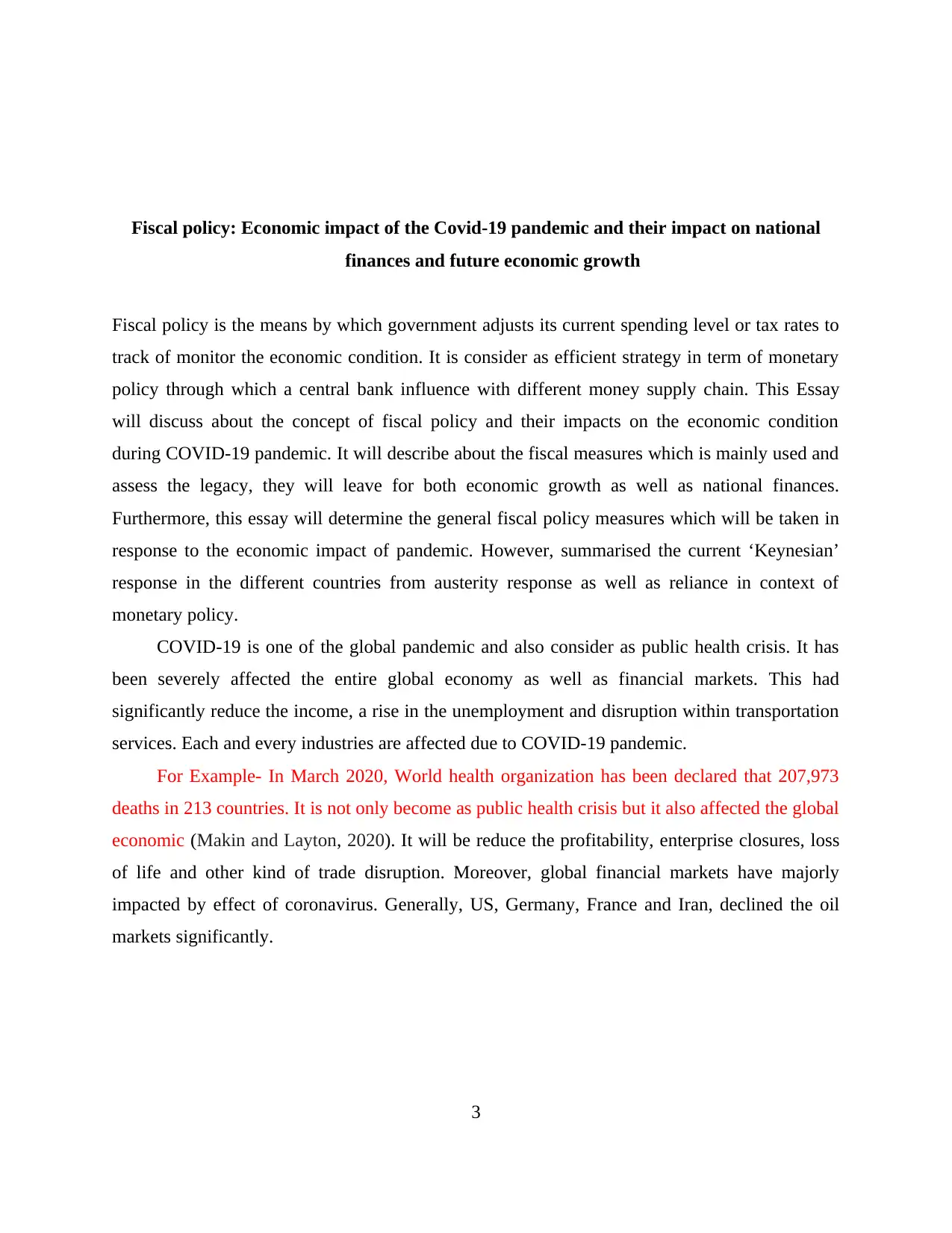
Fiscal policy: Economic impact of the Covid-19 pandemic and their impact on national
finances and future economic growth
Fiscal policy is the means by which government adjusts its current spending level or tax rates to
track of monitor the economic condition. It is consider as efficient strategy in term of monetary
policy through which a central bank influence with different money supply chain. This Essay
will discuss about the concept of fiscal policy and their impacts on the economic condition
during COVID-19 pandemic. It will describe about the fiscal measures which is mainly used and
assess the legacy, they will leave for both economic growth as well as national finances.
Furthermore, this essay will determine the general fiscal policy measures which will be taken in
response to the economic impact of pandemic. However, summarised the current ‘Keynesian’
response in the different countries from austerity response as well as reliance in context of
monetary policy.
COVID-19 is one of the global pandemic and also consider as public health crisis. It has
been severely affected the entire global economy as well as financial markets. This had
significantly reduce the income, a rise in the unemployment and disruption within transportation
services. Each and every industries are affected due to COVID-19 pandemic.
For Example- In March 2020, World health organization has been declared that 207,973
deaths in 213 countries. It is not only become as public health crisis but it also affected the global
economic (Makin and Layton, 2020). It will be reduce the profitability, enterprise closures, loss
of life and other kind of trade disruption. Moreover, global financial markets have majorly
impacted by effect of coronavirus. Generally, US, Germany, France and Iran, declined the oil
markets significantly.
3
finances and future economic growth
Fiscal policy is the means by which government adjusts its current spending level or tax rates to
track of monitor the economic condition. It is consider as efficient strategy in term of monetary
policy through which a central bank influence with different money supply chain. This Essay
will discuss about the concept of fiscal policy and their impacts on the economic condition
during COVID-19 pandemic. It will describe about the fiscal measures which is mainly used and
assess the legacy, they will leave for both economic growth as well as national finances.
Furthermore, this essay will determine the general fiscal policy measures which will be taken in
response to the economic impact of pandemic. However, summarised the current ‘Keynesian’
response in the different countries from austerity response as well as reliance in context of
monetary policy.
COVID-19 is one of the global pandemic and also consider as public health crisis. It has
been severely affected the entire global economy as well as financial markets. This had
significantly reduce the income, a rise in the unemployment and disruption within transportation
services. Each and every industries are affected due to COVID-19 pandemic.
For Example- In March 2020, World health organization has been declared that 207,973
deaths in 213 countries. It is not only become as public health crisis but it also affected the global
economic (Makin and Layton, 2020). It will be reduce the profitability, enterprise closures, loss
of life and other kind of trade disruption. Moreover, global financial markets have majorly
impacted by effect of coronavirus. Generally, US, Germany, France and Iran, declined the oil
markets significantly.
3
⊘ This is a preview!⊘
Do you want full access?
Subscribe today to unlock all pages.

Trusted by 1+ million students worldwide
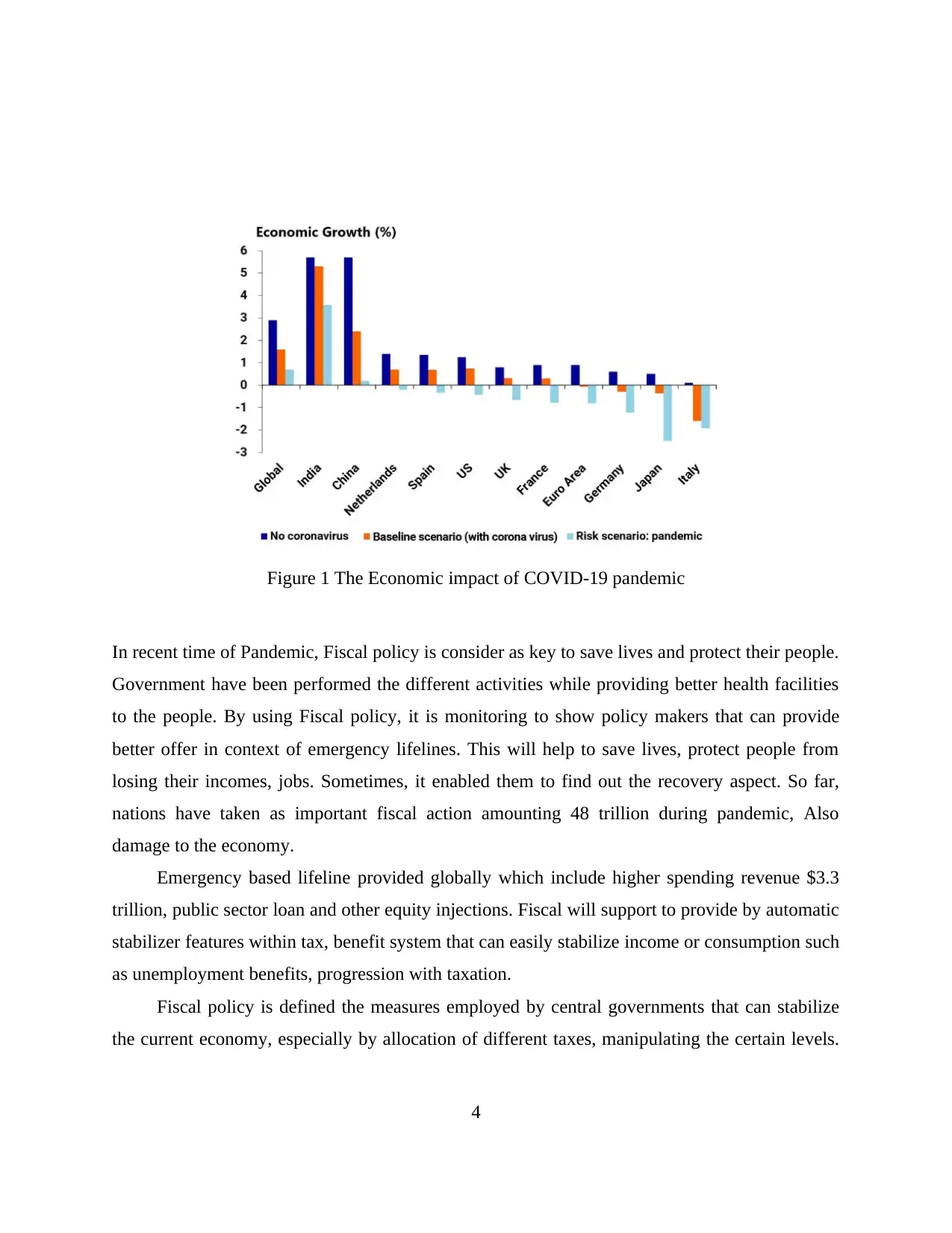
Figure 1 The Economic impact of COVID-19 pandemic
In recent time of Pandemic, Fiscal policy is consider as key to save lives and protect their people.
Government have been performed the different activities while providing better health facilities
to the people. By using Fiscal policy, it is monitoring to show policy makers that can provide
better offer in context of emergency lifelines. This will help to save lives, protect people from
losing their incomes, jobs. Sometimes, it enabled them to find out the recovery aspect. So far,
nations have taken as important fiscal action amounting 48 trillion during pandemic, Also
damage to the economy.
Emergency based lifeline provided globally which include higher spending revenue $3.3
trillion, public sector loan and other equity injections. Fiscal will support to provide by automatic
stabilizer features within tax, benefit system that can easily stabilize income or consumption such
as unemployment benefits, progression with taxation.
Fiscal policy is defined the measures employed by central governments that can stabilize
the current economy, especially by allocation of different taxes, manipulating the certain levels.
4
In recent time of Pandemic, Fiscal policy is consider as key to save lives and protect their people.
Government have been performed the different activities while providing better health facilities
to the people. By using Fiscal policy, it is monitoring to show policy makers that can provide
better offer in context of emergency lifelines. This will help to save lives, protect people from
losing their incomes, jobs. Sometimes, it enabled them to find out the recovery aspect. So far,
nations have taken as important fiscal action amounting 48 trillion during pandemic, Also
damage to the economy.
Emergency based lifeline provided globally which include higher spending revenue $3.3
trillion, public sector loan and other equity injections. Fiscal will support to provide by automatic
stabilizer features within tax, benefit system that can easily stabilize income or consumption such
as unemployment benefits, progression with taxation.
Fiscal policy is defined the measures employed by central governments that can stabilize
the current economy, especially by allocation of different taxes, manipulating the certain levels.
4
Paraphrase This Document
Need a fresh take? Get an instant paraphrase of this document with our AI Paraphraser
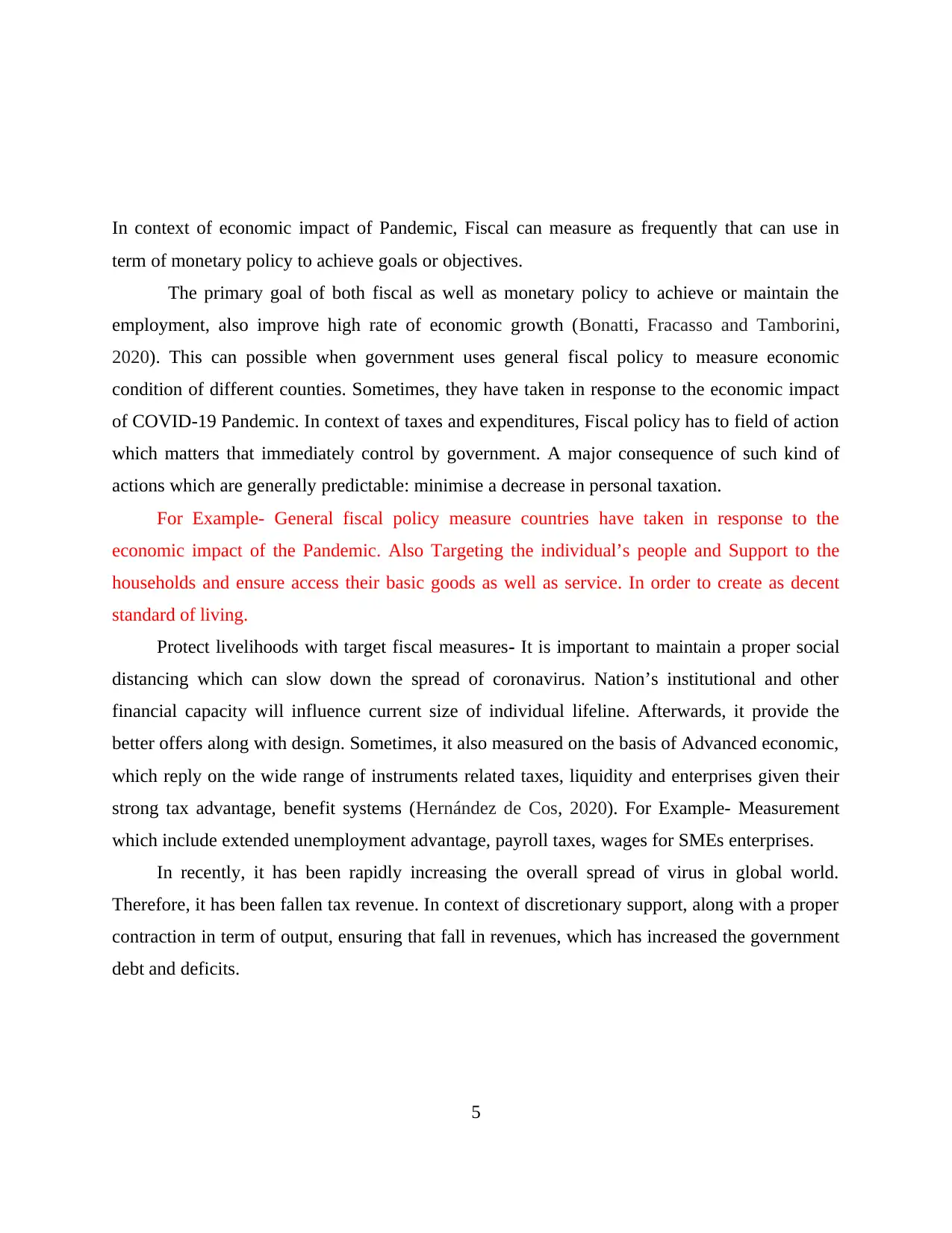
In context of economic impact of Pandemic, Fiscal can measure as frequently that can use in
term of monetary policy to achieve goals or objectives.
The primary goal of both fiscal as well as monetary policy to achieve or maintain the
employment, also improve high rate of economic growth (Bonatti, Fracasso and Tamborini,
2020). This can possible when government uses general fiscal policy to measure economic
condition of different counties. Sometimes, they have taken in response to the economic impact
of COVID-19 Pandemic. In context of taxes and expenditures, Fiscal policy has to field of action
which matters that immediately control by government. A major consequence of such kind of
actions which are generally predictable: minimise a decrease in personal taxation.
For Example- General fiscal policy measure countries have taken in response to the
economic impact of the Pandemic. Also Targeting the individual’s people and Support to the
households and ensure access their basic goods as well as service. In order to create as decent
standard of living.
Protect livelihoods with target fiscal measures- It is important to maintain a proper social
distancing which can slow down the spread of coronavirus. Nation’s institutional and other
financial capacity will influence current size of individual lifeline. Afterwards, it provide the
better offers along with design. Sometimes, it also measured on the basis of Advanced economic,
which reply on the wide range of instruments related taxes, liquidity and enterprises given their
strong tax advantage, benefit systems (Hernández de Cos, 2020). For Example- Measurement
which include extended unemployment advantage, payroll taxes, wages for SMEs enterprises.
In recently, it has been rapidly increasing the overall spread of virus in global world.
Therefore, it has been fallen tax revenue. In context of discretionary support, along with a proper
contraction in term of output, ensuring that fall in revenues, which has increased the government
debt and deficits.
5
term of monetary policy to achieve goals or objectives.
The primary goal of both fiscal as well as monetary policy to achieve or maintain the
employment, also improve high rate of economic growth (Bonatti, Fracasso and Tamborini,
2020). This can possible when government uses general fiscal policy to measure economic
condition of different counties. Sometimes, they have taken in response to the economic impact
of COVID-19 Pandemic. In context of taxes and expenditures, Fiscal policy has to field of action
which matters that immediately control by government. A major consequence of such kind of
actions which are generally predictable: minimise a decrease in personal taxation.
For Example- General fiscal policy measure countries have taken in response to the
economic impact of the Pandemic. Also Targeting the individual’s people and Support to the
households and ensure access their basic goods as well as service. In order to create as decent
standard of living.
Protect livelihoods with target fiscal measures- It is important to maintain a proper social
distancing which can slow down the spread of coronavirus. Nation’s institutional and other
financial capacity will influence current size of individual lifeline. Afterwards, it provide the
better offers along with design. Sometimes, it also measured on the basis of Advanced economic,
which reply on the wide range of instruments related taxes, liquidity and enterprises given their
strong tax advantage, benefit systems (Hernández de Cos, 2020). For Example- Measurement
which include extended unemployment advantage, payroll taxes, wages for SMEs enterprises.
In recently, it has been rapidly increasing the overall spread of virus in global world.
Therefore, it has been fallen tax revenue. In context of discretionary support, along with a proper
contraction in term of output, ensuring that fall in revenues, which has increased the government
debt and deficits.
5
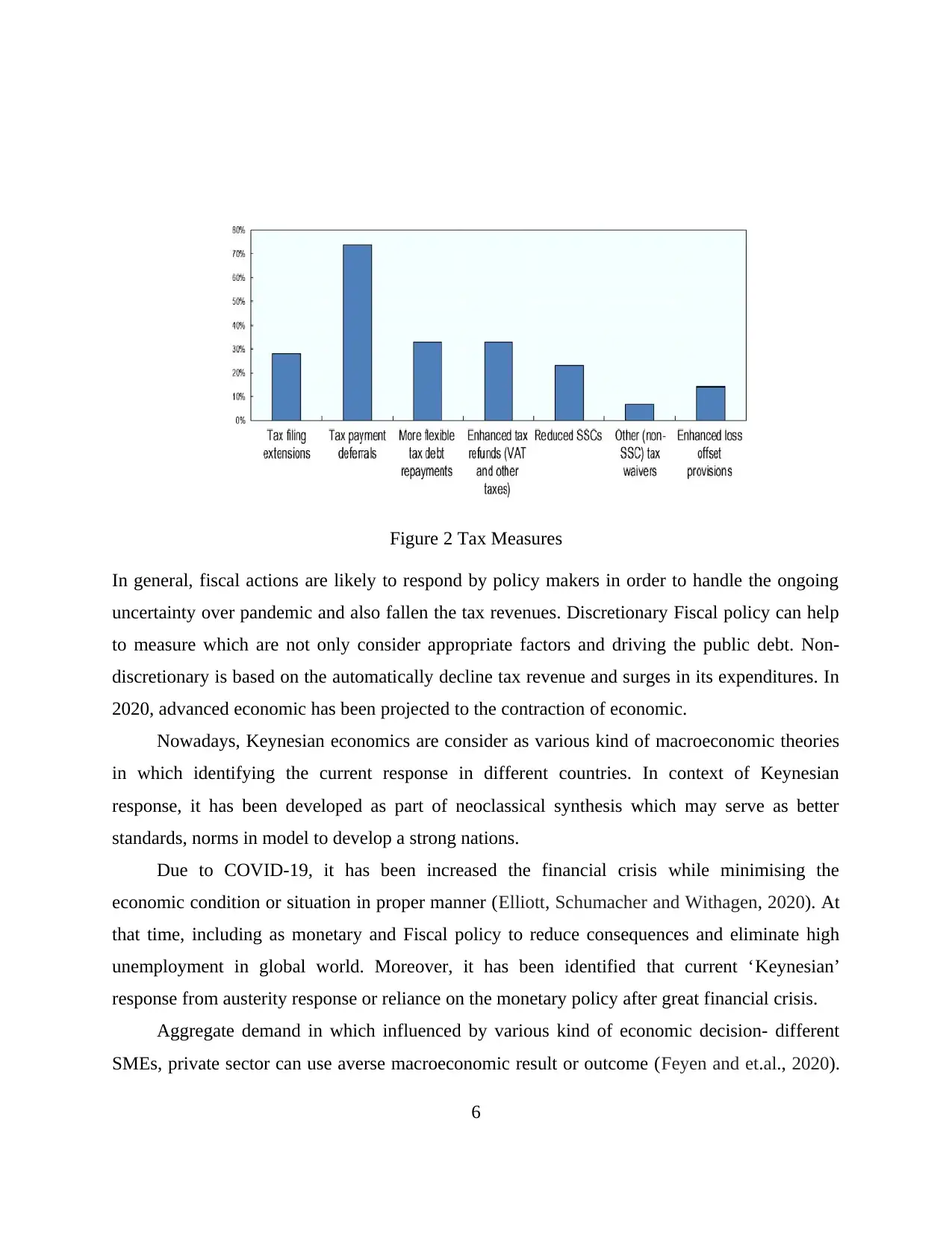
Figure 2 Tax Measures
In general, fiscal actions are likely to respond by policy makers in order to handle the ongoing
uncertainty over pandemic and also fallen the tax revenues. Discretionary Fiscal policy can help
to measure which are not only consider appropriate factors and driving the public debt. Non-
discretionary is based on the automatically decline tax revenue and surges in its expenditures. In
2020, advanced economic has been projected to the contraction of economic.
Nowadays, Keynesian economics are consider as various kind of macroeconomic theories
in which identifying the current response in different countries. In context of Keynesian
response, it has been developed as part of neoclassical synthesis which may serve as better
standards, norms in model to develop a strong nations.
Due to COVID-19, it has been increased the financial crisis while minimising the
economic condition or situation in proper manner (Elliott, Schumacher and Withagen, 2020). At
that time, including as monetary and Fiscal policy to reduce consequences and eliminate high
unemployment in global world. Moreover, it has been identified that current ‘Keynesian’
response from austerity response or reliance on the monetary policy after great financial crisis.
Aggregate demand in which influenced by various kind of economic decision- different
SMEs, private sector can use averse macroeconomic result or outcome (Feyen and et.al., 2020).
6
In general, fiscal actions are likely to respond by policy makers in order to handle the ongoing
uncertainty over pandemic and also fallen the tax revenues. Discretionary Fiscal policy can help
to measure which are not only consider appropriate factors and driving the public debt. Non-
discretionary is based on the automatically decline tax revenue and surges in its expenditures. In
2020, advanced economic has been projected to the contraction of economic.
Nowadays, Keynesian economics are consider as various kind of macroeconomic theories
in which identifying the current response in different countries. In context of Keynesian
response, it has been developed as part of neoclassical synthesis which may serve as better
standards, norms in model to develop a strong nations.
Due to COVID-19, it has been increased the financial crisis while minimising the
economic condition or situation in proper manner (Elliott, Schumacher and Withagen, 2020). At
that time, including as monetary and Fiscal policy to reduce consequences and eliminate high
unemployment in global world. Moreover, it has been identified that current ‘Keynesian’
response from austerity response or reliance on the monetary policy after great financial crisis.
Aggregate demand in which influenced by various kind of economic decision- different
SMEs, private sector can use averse macroeconomic result or outcome (Feyen and et.al., 2020).
6
⊘ This is a preview!⊘
Do you want full access?
Subscribe today to unlock all pages.

Trusted by 1+ million students worldwide
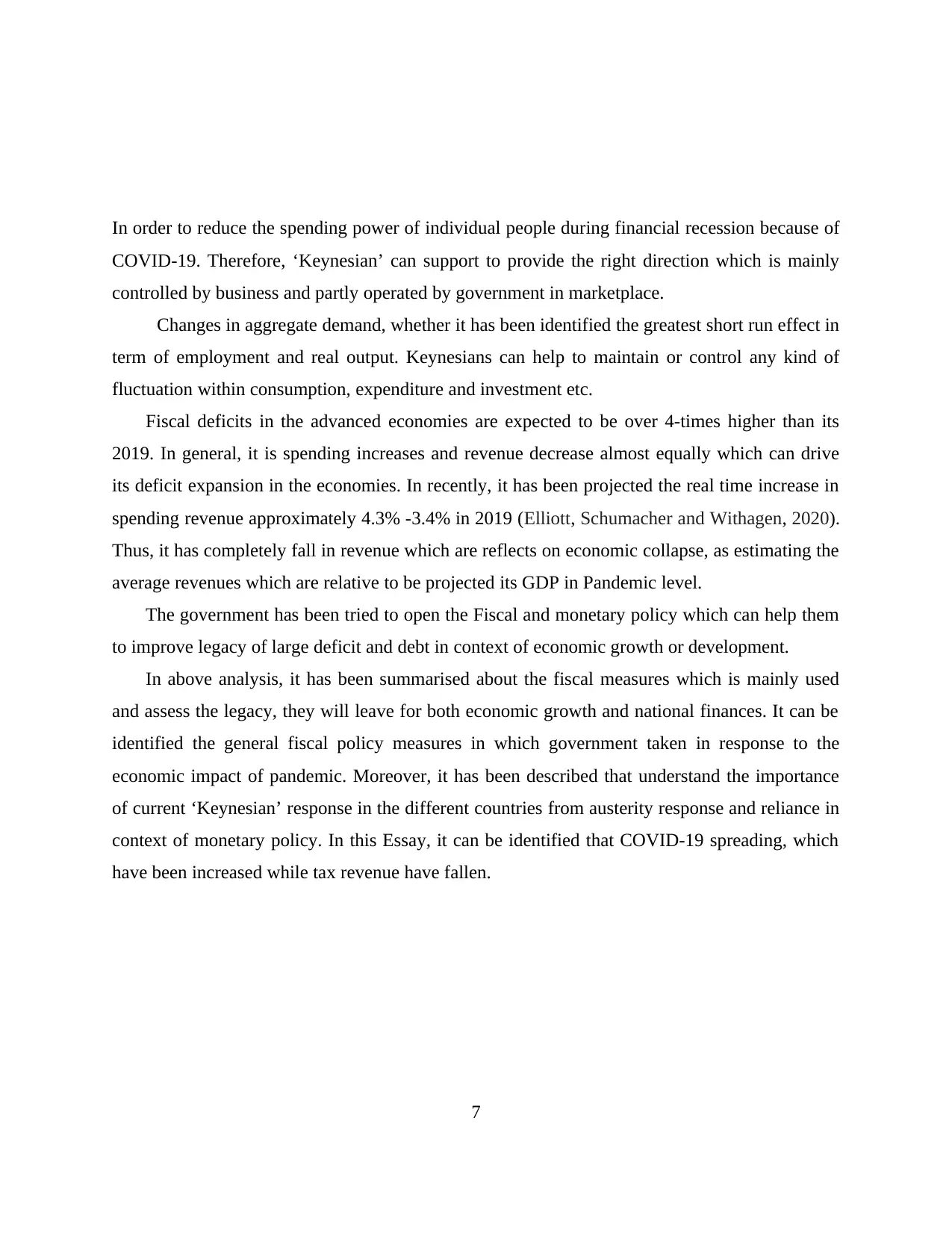
In order to reduce the spending power of individual people during financial recession because of
COVID-19. Therefore, ‘Keynesian’ can support to provide the right direction which is mainly
controlled by business and partly operated by government in marketplace.
Changes in aggregate demand, whether it has been identified the greatest short run effect in
term of employment and real output. Keynesians can help to maintain or control any kind of
fluctuation within consumption, expenditure and investment etc.
Fiscal deficits in the advanced economies are expected to be over 4-times higher than its
2019. In general, it is spending increases and revenue decrease almost equally which can drive
its deficit expansion in the economies. In recently, it has been projected the real time increase in
spending revenue approximately 4.3% -3.4% in 2019 (Elliott, Schumacher and Withagen, 2020).
Thus, it has completely fall in revenue which are reflects on economic collapse, as estimating the
average revenues which are relative to be projected its GDP in Pandemic level.
The government has been tried to open the Fiscal and monetary policy which can help them
to improve legacy of large deficit and debt in context of economic growth or development.
In above analysis, it has been summarised about the fiscal measures which is mainly used
and assess the legacy, they will leave for both economic growth and national finances. It can be
identified the general fiscal policy measures in which government taken in response to the
economic impact of pandemic. Moreover, it has been described that understand the importance
of current ‘Keynesian’ response in the different countries from austerity response and reliance in
context of monetary policy. In this Essay, it can be identified that COVID-19 spreading, which
have been increased while tax revenue have fallen.
7
COVID-19. Therefore, ‘Keynesian’ can support to provide the right direction which is mainly
controlled by business and partly operated by government in marketplace.
Changes in aggregate demand, whether it has been identified the greatest short run effect in
term of employment and real output. Keynesians can help to maintain or control any kind of
fluctuation within consumption, expenditure and investment etc.
Fiscal deficits in the advanced economies are expected to be over 4-times higher than its
2019. In general, it is spending increases and revenue decrease almost equally which can drive
its deficit expansion in the economies. In recently, it has been projected the real time increase in
spending revenue approximately 4.3% -3.4% in 2019 (Elliott, Schumacher and Withagen, 2020).
Thus, it has completely fall in revenue which are reflects on economic collapse, as estimating the
average revenues which are relative to be projected its GDP in Pandemic level.
The government has been tried to open the Fiscal and monetary policy which can help them
to improve legacy of large deficit and debt in context of economic growth or development.
In above analysis, it has been summarised about the fiscal measures which is mainly used
and assess the legacy, they will leave for both economic growth and national finances. It can be
identified the general fiscal policy measures in which government taken in response to the
economic impact of pandemic. Moreover, it has been described that understand the importance
of current ‘Keynesian’ response in the different countries from austerity response and reliance in
context of monetary policy. In this Essay, it can be identified that COVID-19 spreading, which
have been increased while tax revenue have fallen.
7
Paraphrase This Document
Need a fresh take? Get an instant paraphrase of this document with our AI Paraphraser
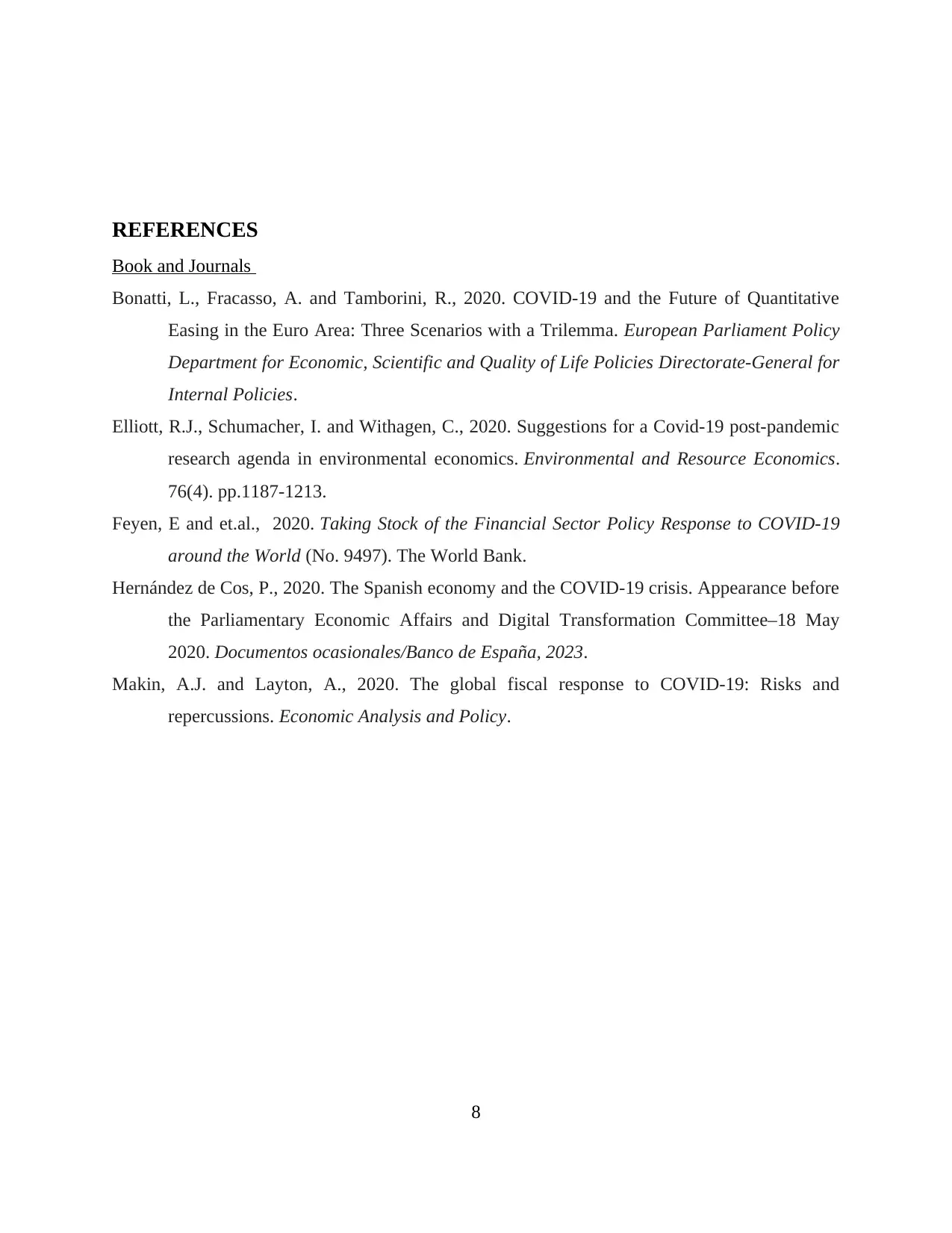
REFERENCES
Book and Journals
Bonatti, L., Fracasso, A. and Tamborini, R., 2020. COVID-19 and the Future of Quantitative
Easing in the Euro Area: Three Scenarios with a Trilemma. European Parliament Policy
Department for Economic, Scientific and Quality of Life Policies Directorate-General for
Internal Policies.
Elliott, R.J., Schumacher, I. and Withagen, C., 2020. Suggestions for a Covid-19 post-pandemic
research agenda in environmental economics. Environmental and Resource Economics.
76(4). pp.1187-1213.
Feyen, E and et.al., 2020. Taking Stock of the Financial Sector Policy Response to COVID-19
around the World (No. 9497). The World Bank.
Hernández de Cos, P., 2020. The Spanish economy and the COVID-19 crisis. Appearance before
the Parliamentary Economic Affairs and Digital Transformation Committee–18 May
2020. Documentos ocasionales/Banco de España, 2023.
Makin, A.J. and Layton, A., 2020. The global fiscal response to COVID-19: Risks and
repercussions. Economic Analysis and Policy.
8
Book and Journals
Bonatti, L., Fracasso, A. and Tamborini, R., 2020. COVID-19 and the Future of Quantitative
Easing in the Euro Area: Three Scenarios with a Trilemma. European Parliament Policy
Department for Economic, Scientific and Quality of Life Policies Directorate-General for
Internal Policies.
Elliott, R.J., Schumacher, I. and Withagen, C., 2020. Suggestions for a Covid-19 post-pandemic
research agenda in environmental economics. Environmental and Resource Economics.
76(4). pp.1187-1213.
Feyen, E and et.al., 2020. Taking Stock of the Financial Sector Policy Response to COVID-19
around the World (No. 9497). The World Bank.
Hernández de Cos, P., 2020. The Spanish economy and the COVID-19 crisis. Appearance before
the Parliamentary Economic Affairs and Digital Transformation Committee–18 May
2020. Documentos ocasionales/Banco de España, 2023.
Makin, A.J. and Layton, A., 2020. The global fiscal response to COVID-19: Risks and
repercussions. Economic Analysis and Policy.
8
1 out of 8
Related Documents
Your All-in-One AI-Powered Toolkit for Academic Success.
+13062052269
info@desklib.com
Available 24*7 on WhatsApp / Email
![[object Object]](/_next/static/media/star-bottom.7253800d.svg)
Unlock your academic potential
Copyright © 2020–2025 A2Z Services. All Rights Reserved. Developed and managed by ZUCOL.




